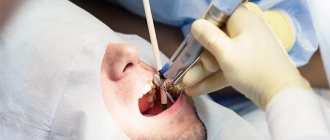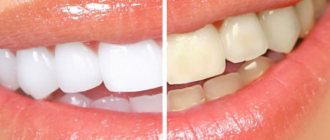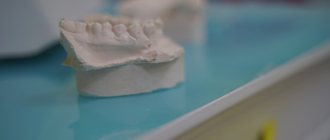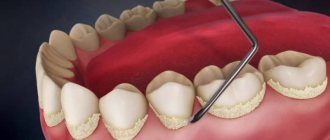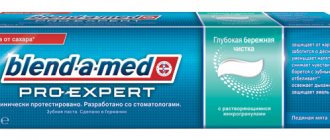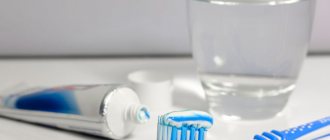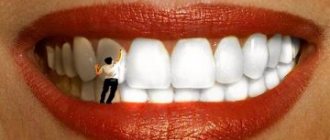The deposits on the teeth that a regular brush does not remove gradually thicken and harden, turning into tartar. This destroys the enamel and prevents damage from being noticed in time. As a result, caries develops, which can develop into more serious diseases. Complications also affect the gums - bleeding and inflammation appear. Regular dental cleanings reduce the likelihood of tooth decay and maintain a beautiful, healthy smile.
Previously, plaque was removed using a curette, but this injured delicate tissues. Modern gentle methods in dentistry are ultrasonic cleaning or Air Flow. They are recommended not only as a disease prevention, but also for preparing teeth before treatment, installation of crowns, implants or braces.
What is tartar and what are the causes of its appearance?
Tartar is hardened plaque that forms on the visible part of the tooth (crown) and under the gum.
The reasons for its appearance are natural, but the consequences can cause pathologies in the oral cavity.
Initially, food particles stick to the enamel. Bacteria begin to actively multiply in them. A dental plaque is formed, which looks like a soft, light plaque. Plaque can be easily removed by regular tooth brushing. But if this does not happen, then food debris, dead cells of the mucous membrane, calcium and phosphorus salts from saliva are layered on the soft plaque. They crystallize and harden.
Mineralization occurs on average within 12 days. Soft plaque turns into hard plaque. Tartar has a rough surface, onto which more and more elements “cling.”
Attention: A bacterial film on teeth forms within 16 hours. Therefore, it is important to brush your teeth at least twice a day.
Photo of plaque, male jaw
Why hard deposits form
Plaque formation is inevitable, but there are a number of factors that accelerate the process:
- Irregular hygiene. Particularly active formation of plaque and stone occurs at night: salivation decreases, a person swallows less often, and does not move the tongue. This creates a favorable environment for bacterial growth.
- Poor hygiene. Brushing teeth with horizontal movements does not affect hard-to-reach areas. The interdental spaces should be cleaned by moving the brush vertically.
- Diet. A large amount of sweet and starchy foods leads to the sticking of carbohydrates to the enamel and the proliferation of pathogenic microflora. To reduce the rate of plaque formation, you should eat fresh, firm vegetables and fruits. Chewing the fibrous pulp for a long time partially helps remove plaque.
- Physiological features. Incorrect bite and crowded teeth make proper cleaning difficult.
- Metabolic disorders. The composition of saliva changes, its bactericidal properties decrease.
- Smoking. Cigarette tar settles on the teeth, causing the formation of films and plaques.
About the procedure
Tartar is a plaque that, as a result of prolonged presence on the enamel, has become hard.
Such stone has such a strong adhesion to teeth that it is impossible to remove it with toothpaste and a brush. To clean enamel in dentistry, professional methods and products are used. The cleaning technology involves non-contact manipulation, which prevents mechanical damage and infection. Under the influence of high temperatures of infrared radiation, all particles of moisture are removed from pathological formations, and bacteria die. The laser not only cleans the enamel, but also polishes and whitens it.
The price for laser teeth cleaning from tartar depends on the number of teeth affected by hard plaque. Laser cleansing is not a cheap procedure because the procedure has many advantages over other methods.
Why is ultrasonic cleaning necessary?
Professional teeth cleaning in a clinic identifies problem areas and helps avoid future diseases.
- Detects caries. The destruction of enamel and dentin can be hidden under a layer of tartar. If caries is discovered later, it should be cured.
- Prevents the formation of new caries, including those who wear braces.
- Prevents gum inflammation, periodontitis, exposed roots, bleeding, and bad breath.
- Prepares the oral cavity for surgery and implant installation. Removing colonies of bacteria living in dental plaque ensures the safety of manipulations that violate the integrity of tissues.
- Brightens teeth without aggressive chemical whitening.
Photos BEFORE and AFTER cleaning
Dental and oral hygiene in dentistry: why is it so important to undergo the procedure regularly?
The main task of oral hygiene is to remove hard and soft plaque from the surfaces of the teeth, as well as other areas and areas of the mouth.
Regular and timely removal of dental plaque will be the best prevention of caries and other dental diseases. In addition, oral hygiene in dentistry contributes to:
- Formation of healthy strong teeth;
- Complete destruction of harmful microorganisms that live in large numbers in the human oral cavity;
- Prevention of periodontal and gastrointestinal diseases.
Professional dental and oral hygiene helps keep your teeth enamel in excellent condition - after brushing, your teeth become whiter and your smile looks attractive! Professional oral hygiene is especially recommended for people with bad habits: smokers, patients who abuse strong tea and coffee. The procedure is also indicated for people with poor immunity, because often malfunctions in the body’s immune system are expressed precisely in the appearance of caries and inflammation in the oral cavity.
Regular dental hygiene will ultimately result in significant savings on dental treatment costs.
Which is inevitable if the teeth are not properly cared for and are covered with a thick layer of plaque. So, professional oral hygiene is certainly not a waste of time and money; on the contrary, it is a valuable investment in your own health!
Is ultrasonic teeth cleaning harmful?
Ultrasonic cleaning does not pose any threat to teeth and the body as a whole. An exception is situations in which the technology is broken or the patient has contraindications. Ultrasound can damage enamel if it is thinned or has such a structural feature. Sometimes brushing causes bleeding from the gums. The doctor will help stop it and advise what needs to be done for speedy healing.
Advice: to avoid possible troubles, before starting the procedure, the dentist finds out the state of health, concomitant diseases, and reaction to medications. Answer honestly and directly, every nuance matters.
Price for professional dental and oral hygiene in dentistry
To find out the exact price of professional dental and oral hygiene services, you will need to come to the clinic and undergo an examination by a dentist. This is important because the type of teeth cleaning will be determined based on your individual characteristics. Perhaps you have contraindications for some type of cleaning, or in your case a certain technology will work optimally.
If you want to find out the maximum useful details not only about the cost of a professional oral hygiene procedure, but also about the stages of its implementation, the doctors of our dentistry in Moscow “Firadent” will be happy to help you!
You can get a detailed free consultation from our specialists at any time convenient for you: just contact us by phone number and make an appointment!
"Firadent" - we will help make your teeth healthy and your smile bright and attractive!
Pros and cons of ultrasonic tartar removal
Unlike other methods, ultrasonic cleaning has a number of advantages:
- Removes subgingival calculus that is difficult to reach with traditional instruments. To clean the root zone, the doctor pulls back the gums and works with the neck and root of the tooth.
- Cleans the interdental spaces even of very dense teeth, uneven, overlapping one another.
- The procedure does not last long - 40-60 minutes.
- Painless. The patient does not feel any impact.
- Non-contact influence. Only air and water come into contact with teeth. With the outdated mechanical method, the instruments scratch the enamel and cause an unpleasant “grinding” sensation.
Innovative professional prevention with the AIR FLOW PROMASTER device
Only in our clinic in the Zhulebino area and Lyubertsy! The most modern equipment for professional hygiene Air flow Prophylaxis Master (Switzerland) . A device that includes 3 technologies:
- PIEZON NO PAIN (smooth ultrasonic vibrations to reduce pain)
- Air-Flow (removal of pigmented plaque in the supragingival area)
- Perio-Flow (gentle cleaning and polishing of the subgingival area of the tooth or implant surface).
from biofilm and dental plaque 2 times more effectively
5 times less discomfort from the procedure . Absolutely painless!
The duration of the procedure is 2 times shorter!
No more gum injections or hand instruments. Removal of dental plaque even in periodontal pockets, around implants and orthodontic structures.
To prevent oral diseases, dentists recommend professional oral hygiene every six months. Traditional professional hygiene includes dental treatment with ultrasound and an Air flow device. Additional cleaning is carried out with a hand tool - in simple terms, where tartar cannot be removed under the influence of ultrasound (under the gum in pockets), it is scraped off with a sharp instrument - a curette, after which the tooth is polished with rubber cups with abrasive pastes. But in our dentistry this now happens differently.
Our Aesthetic Dentistry Clinic has introduced an absolutely new product for 2022 – the AIR FLOW PROMASTER professional teeth cleaning system.
The main differences from previous generations of occupational hygiene devices:
- A wider spectrum of action - cleaning even in deep periodontal pockets , where previously it was possible to remove tartar and deposits only surgically under anesthesia, cleaning in the area of gum recession, cleaning crowns and implants.
- Only this device is guaranteed to remove biofilm from teeth and gums.
Biofilm is a colony of microorganisms on the surface of the oral cavity, held together by cells. Biofilm is a major factor in the development of caries and periodontal infections.
Home cleaning of teeth and gums, and even the use of an irrigator, unfortunately, removes only 50% of all biofilm microbes present.
The AIR FLOW PRO MASTER device guarantees absolute comfort during the Procedure. We tested this ourselves. This was confirmed by our patients.
- Never before has professional hygiene been so painless.
- In 99% of cases, our patients tolerate the procedure without anesthesia.
- The procedure is much faster - on average 2 times.
Innovative technology of professional hygiene from the Denta-Professional Aesthetic Dentistry Clinic comfortably and effectively eliminates:
- biofilm,
- pigmentation,
- supragingival and subgingival dental deposits,
Forget scary-looking sharp curettes for scraping plaque. No more hand tools, rubber cups, brushes or pastes!
The device is effective in working with total prosthetics, restorations, and bracket systems. The biofilm has been completely removed. The surface is cleaned to the depth of pores. No scratches. The enamel prisms remain intact and the surface is absolutely smooth. The tongue no longer feels rough and there is no need to polish with (abrasive) pastes. This preserves the enamel and prevents the development of diseases.
The device consists of three devices:
- Air-flow nozzle. The nozzle in this device differs from conventional airflow devices in the ability to use the new generation PLUS powder. Unlike classic powder, which is used in conventional Airflow devices, the particle size of the powder is several times smaller, due to which gentle processing is achieved and the device can be used even on all soft tissues, including gums, mucous membranes, tongue and palate. The previous generation of the device with classic powder would simply damage soft tissues.
- The second attachment for minimally invasive scaling is PIEZON® NO PAIN (that is, absolutely painless). Soft ultrasound for removing dental plaque.
- PERIO-FLOW nozzle – gentle cleaning and polishing of the subgingival area and implant surface. Prevents the development of re-implantitis after implantation surgeries.
All procedures are carried out with the supply of warm water to the treatment site with the ability to regulate the temperature, which helps to completely relieve pain.
The procedure was highly appreciated by patients with hypersensitive teeth.
AIRFLOW® Prophylaxis Master is the latest technological innovation from EMS, a unique solution for the prevention of caries, periodontal disease and maintenance treatment. The device has unique ergonomics, high accuracy, easy maintenance and meets the highest hygienic standards.
This is a very expensive device and not every clinic can afford it. We have invested in the comfort and health of our patients.
Sign up for the procedure by phone or through the online registration form.
The cost of innovative professional prevention with the AIR FLOW PROMASTER device is 8,000 rubles. This is the lowest price for such a procedure in Moscow.
Main stages of ultrasonic processing
The dentist conducts an examination, identifies places where tartar accumulates, the amount, and determines its density in order to choose the appropriate cleaning regimen. Sometimes teeth are treated with a special solution that reveals the boundaries of plaque. If the patient has sensitive teeth, gums or deep subgingival calculus, anesthesia (injection or application) is performed.
Stone removal is carried out in three stages:
Brushing teeth with a skyler
Skyler is a dental instrument that generates ultrasonic air vibrations. Water (an antiseptic solution) mixed with air is sprayed through a narrow nozzle. The liquid is intended to cool the tooth and wash away the separated plaque.
The ultrasonic wave forms cavities in mineralized deposits, the plaque cracks and peels off from the enamel. The fragments are removed with a saliva ejector.
First, the doctor cleans the crowns, then the subgingival area, guiding the scaler with parallel vertical movements.
Brushing teeth with a skyler
Polishing
Cleaned teeth have a rough surface. To slow down the adhesion of food and bacteria, polishing is used.
Main types:
- Mechanical with special paste and a round elastic brush. The interdental spaces are polished with thin strips or narrow spiral-shaped brushes.
- Hardware using the AirFlow method - using a powerful jet of water with an abrasive containing sodium bicarbonate.
Brushing your teeth with a special paste and a round brush
Fluoridation
Fluoridation helps strengthen enamel and reduce hyperesthesia (sensitivity) in the cervical area.
- The tooth surface is dried with a stream of warm air for better adhesion.
- Apply a composition containing fluoride ions (gel or varnish) and dry again.
- The teeth are treated with a swab soaked in copper hydroxide and calcium solution. The substances enter into a chemical reaction, and calcium fluoride crystals are formed in the dentinal tubules and other irregularities, which strengthen the tooth tissue and prevent infection.
Contraindications
The most important contraindication is the presence of a pacemaker in the patient. Ultrasonic waves can disrupt its operation.
Other restrictions also apply to health conditions:
- asthma, bronchospasm, tuberculosis,
- increased risk of bleeding,
- allergies to the drugs used,
- infectious and viral diseases,
- oncology,
- mental illness, epilepsy.
Attention: Relative contraindications are pregnancy (first trimester), childhood (up to 16-18 years). The decision to perform the procedure is made by the dentist.
When it might be painful or unpleasant
Ultrasonic cleaning is a modern, effective method with minimal trauma. Most patients tolerate the process without discomfort.
Pain when cleaning with ultrasound
Pain can occur due to individual characteristics or due to erroneous actions of the doctor.
Features include thin, sensitive enamel - a semblance of shocks and pressure is felt. Weakened gums that are prone to bleeding are easily subject to microdamage and painful sensations appear. If there is extensive subgingival calculus, the doctor works in this area for a long time, which can also lead to discomfort.
Is there any discomfort during laser cleaning?
This method does not cause pain. The laser beam destroys pigments and evaporates water in hard and soft deposits. Their remains are washed off from the surface with water. In this case, there is no effect on the enamel. Gum pockets are not treated with laser; therefore, there is no contact with soft tissues.
Features of chemical tartar removal
The method is rarely used, because has few advantages, including speed and affordable price. Chemical removal has more disadvantages: thinning of the enamel, possible burns of the mucous membrane if performed incorrectly, poor cleaning of the interdental space, allergies to the products used, oxidation of orthodontic metal structures.
Sequencing:
- installation of protective plates on the gums,
- applying acidic and alkaline compounds for 2-3 minutes,
- rinsing, polishing, fluoridation.
Chemical removal of tartar
How painful is it to remove stone manually?
This contact method can only be painful if the doctor's hand accidentally slips and the instrument scratches the gum. Also, the disadvantages include incomplete removal of plaque and stone in hard-to-reach places. Mechanical cleaning is contraindicated for thin, sensitive enamel, inflammation of the gums, and infectious lesions of the mucous membrane.
Nowadays, dentists recommend removing tartar manually less and less often.
Application of anesthesia
When brushing, the surface of the tooth is affected, and if the enamel is thinned or damaged, unpleasant, slightly painful sensations may occur during the procedure. In people with increased tooth sensitivity, pain is more severe, especially when removing stones from subgingival pockets. To reduce these sensations, dentists use local anesthesia.
For people with hypersensitive teeth, cleaning is done under local anesthesia.
Most often, such anesthesia involves applying an anesthetic gel to the gums. The effect manifests itself in a matter of minutes and the doctor’s manipulations become completely painless. All that remains are tactile sensations, which also do not cause much concern. Anesthesia in the form of an injection when brushing teeth is used less frequently, mainly for those patients who are terrified of dentists or suffer from dental hypersensitivity.
- It hurts to chew on a tooth
There is another method of pain relief that has proven itself well. We are talking about the use of nitrous oxide - a gas, when inhaled, the patient feels slight relaxation and euphoria, but at the same time is in complete control of himself. This anesthesia is indicated for those who are afraid of dental procedures, susceptible to stress and depression, as well as those who suffer from hypersensitivity, but have contraindications to the use of local anesthetics or general anesthesia.
Nitrous oxide sedation machine
Important! This method cannot be used for serious mental disorders, problems with the respiratory tract, or in the first months of pregnancy.
How to clean teeth with this anesthesia:
- a mask is placed on the patient’s nose, through which oxygen begins to flow;
- then nitrous oxide is mixed with oxygen in a certain concentration;
- the gas begins to act in 2-3 minutes, and the dentist can begin the necessary manipulations.
Nitrous oxide is supplied through a special mask
During the process of brushing teeth, the doctor can change the gas concentration, guided by the patient’s reaction to his actions. In addition to the fact that nitrous oxide has a relaxing effect, it also helps reduce the gag reflex that many people experience during dental procedures. After completing the procedure, the mask is removed, and all sensations return to normal almost instantly.

